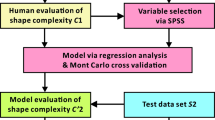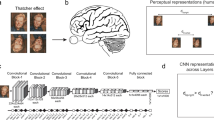Abstract
Visual area V4 plays an important role in the neural mechanism of shape recognition. V4 neurons exhibit selectivity for the orientation and curvature of boundary fragments. In this paper, we propose a novel neural network model of V4 for shape-based feature extraction and other vision tasks. The low-level layers of the model consist of computational units simulating simple cells and complex cells in the primary visual cortex. These layers extract preliminary visual features including edges and orientations. The V4 computational units calculate the entropy of the extracted features as a measure of visual saliency. The features around salient points are then selected and encoded with a layer of restricted Boltzmann machine to generate an intermediate representation of object shapes. The model is evaluated in shape distinction, feature detection, feature matching, and object discrimination experiments. The results demonstrate that this model generates discriminative local representation of object shapes. It shows a successful attempt to construct a computation model of visual object recognition in the brain.















Similar content being viewed by others
Explore related subjects
Discover the latest articles, news and stories from top researchers in related subjects.References
Smeulders AWM, Worring M, Santini S, Gupta A, Jain R. Content-based image retrieval at the end of the early years. IEEE Trans Pattern Anal Mach Intell. 2000;22(12):1349–80.
Ettlinger G. “Object vision” and “spatial vision”: the neuropsychological evidence for the distinction. Cortex. 1990;26(3):319–41.
Hubel DH, Wiesel TN. Receptive fields, binocular interaction and functional architecture in the cat’s visual cortex. J Physiol. 1962;160(1):106.
Bell AH, Hadj-Bouziane F, Frihauf JB, Tootell RBH, Ungerleider LG. Object representations in the temporal cortex of monkeys and humans as revealed by functional magnetic resonance imaging. J Neurophysiol. 2009;101(2):688–700.
Gallant JL, Connor CE, Rakshit S, Lewis JW, Van Essen DC. Neural responses to polar, hyperbolic, and Cartesian gratings in area V4 of the macaque monkey. J Neurophysiol. 1996;76(4):2718–39.
Pasupathy A, Connor CE. Shape representation in area V4: position-specific tuning for boundary conformation. J Neurophysiol. 2001;86(5):2505–19.
David SV, Hayden BY, Gallant JL. Spectral receptive field properties explain shape selectivity in area V4. J Neurophysiol. 2006;96(6):3492–505.
Cadieu C, Kouh M, Pasupathy A, Connor CE, Riesenhuber M, Poggio T. A model of V4 shape selectivity and invariance. J Neurophysiol. 2007;98(3):1733–50.
Riesenhuber M, Poggio T. Hierarchical models of object recognition in cortex. Nat Neurosci. 1999;2(11):1019–25.
Bengio Y. Learning deep architectures for AI. Found Trends Mach Learn. 2009;2(1):1–127.
Krizhevsky A, Sutskever Il, Hinton GE. Imagenet classification with deep convolutional neural networks. In: Advances in neural information processing systems. 2012. p. 1097–105.
Boureau Y-L, Ponce J, LeCun Y. A theoretical analysis of feature pooling in visual recognition. In: Proceedings of the international conference on machine learning. 2010. p. 111–8.
Desimone R, Duncan J. Neural mechanisms of selective visual attention. Annu Rev Neurosci. 1995;18(1):193–222.
Sasaki Y, Vanduffel W, Knutsen T, Tyler C, Tootell R. Symmetry activates extrastriate visual cortex in human and nonhuman primates. Proc Natl Acad Sci USA. 2005;102(8):3159–63.
Hinton G. A practical guide to training restricted Boltzmann machines. Momentum. 2010;9(1):926.
Pasupathy A, Connor CE. Responses to contour features in macaque area V4. J Neurophysiol. 1999;82(5):2490–502.
Mikolajczyk K, Schmid C. A performance evaluation of local descriptors. IEEE Trans Pattern Anal Mach Intell. 2005;27(10):1615–30.
Lowe DG. Object recognition from local scale-invariant features. In: Proceedings of the IEEE international conference on computer vision, volume 2. IEEE, 1999. p. 1150–57.
Vedaldi A, Fulkerson B. Vlfeat: an open and portable library of computer vision algorithms. In: Proceedings of the international conference on multimedia. ACM, 2010. p. 1469–72.
Fei-Fei L, Fergus R, Perona P. Learning generative visual models from few training examples: an incremental bayesian approach tested on 101 object categories. Comput Vis Image Underst. 2007;106(1):59–70.
Grauman K, Darrell T. The pyramid match kernel: discriminative classification with sets of image features. In: Proceedings of the IEEE international conference on computer vision, volume 2. IEEE, 2005. p. 1458–65.
Lazebnik S, Schmid C, Ponce J. Beyond bags of features: spatial pyramid matching for recognizing natural scene categories. In: Proceedings of the IEEE conference on computer vision and pattern recognition, volume 2. IEEE, 2006. p. 2169–78.
Zhang H, Berg AC, Maire M, Malik J. SVM-KNN: discriminative nearest neighbor classification for visual category recognition. In: Proceedings of the IEEE conference on computer vision and pattern recognition, volume 2. IEEE, 2006. p. 2126–36.
Wang G, Zhang Y, Fei-Fei L. Using dependent regions for object categorization in a generative framework. In: Proceedings of the IEEE conference on computer vision and pattern recognition, volume 2. IEEE, 2006. p. 1597–604.
Bosch A, Zisserman A, Munoz X. Image classification using random forests and ferns. In: Proceedings of the IEEE international conference on computer vision. IEEE, 2007. p. 1–8.
Boiman O, Shechtman E, Irani M. In defense of nearest-neighbor based image classification. In: Proceedings of the IEEE conference on computer vision and pattern recognition. IEEE, 2008. p. 1–8.
Liu B-D, Wang Y-X, Zhang Y-J, Shen B. Learning dictionary on manifolds for image classification. Pattern Recogn. 2013;46(7):1879–90.
Heo B, Jeong H, Kim J, Choi S-Il, Choi JY. Weighted pooling based on visual saliency for image classification. In: Advances in visual computing. Springer, 2014. p. 647–657.
Wei H, Li H. Shape description and recognition method inspired by the primary visual cortex. Cogn Comput. 2014;6(2):164–74.
Wei H, Li Q, Dong Z. Learning and representing object shape through an array of orientation columns. IEEE Trans Neural Netw Learn Syst. 2014;25(7):1346–58.
Zhao J, Du C, Sun H, Liu X, Sun J. Biologically motivated model for outdoor scene classification. Cogn Comput. 2013;7(1):20–33.
Acknowledgments
This work was supported by the NSFC project (Project No. 61375122), and the National Twelfth Five-Year Plan for Science and Technology (Project No. 2012BAI37B06). And this work was also supported (in part) by Shanghai Science and Technology Development Funds (13dz2260200, 13511504300).
Author information
Authors and Affiliations
Corresponding author
Rights and permissions
About this article
Cite this article
Wei, H., Dong, Z. V4 Neural Network Model for Shape-Based Feature Extraction and Object Discrimination. Cogn Comput 7, 753–762 (2015). https://doi.org/10.1007/s12559-015-9361-9
Received:
Accepted:
Published:
Issue Date:
DOI: https://doi.org/10.1007/s12559-015-9361-9




